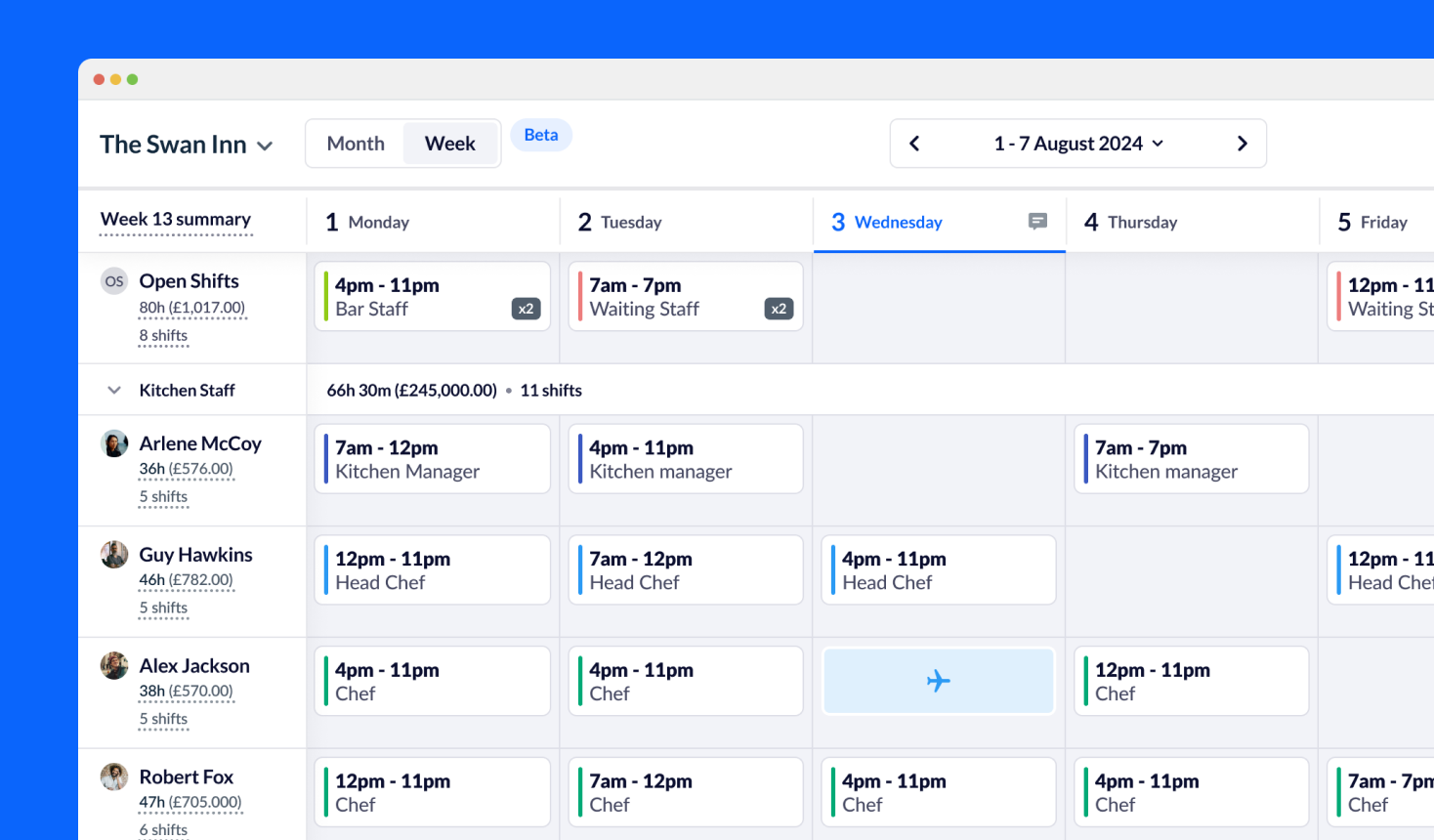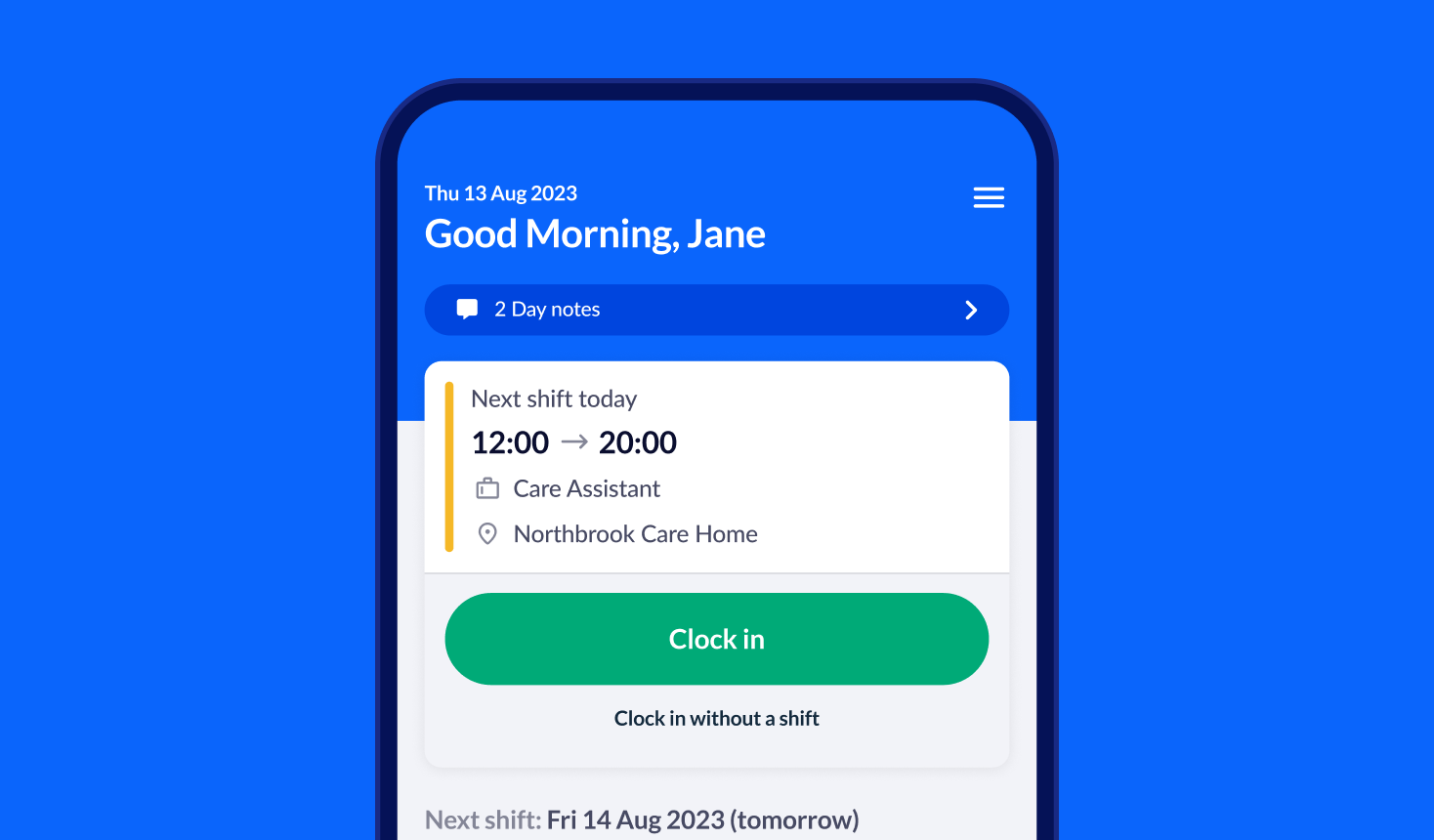Introduction
How to make a rota and schedule shifts for your staff

If you employ shift-based workers or your business runs on a variable schedule, then rota planning is a business-critical task. But for most managers, staff scheduling and shift planning are a source of frustration and headaches — not to mention a huge time vacuum.
Creating the rota, sending it to staff, and having to make changes once it’s in employees’ hands, is incredibly time-consuming. And rota mix-ups like staff no-shows or double-bookings happen all too often.
Making the perfect rota can feel like an impossible task, but any improvement to your planning processes are likely to be positive for you, your staff and your business. Even little tweaks may bring benefits. For example, changing how you plan and make your staff rotas can:
- Reduce conflict with employees over pay, shift patterns, holidays and working hours
- Help to balance labour costs and service levels, and reduce the chance of over- or understaffing
- Limit scheduling mix-ups and their associated costs
- Reclaim the time you currently spend rota planning and updating, and use the extra hours to focus on more important areas of your business.
In fact, we found that improving rota management can cut planning time by two-thirds, reclaiming 170 hours of your time, every year.

What is a rota?
A rota, otherwise known as a roster, duty roster, staff schedule or staff timetable, is a chart that sets out the days and times when different employees are scheduled to work or perform certain duties. In its simplest form, a rota is a list of shifts that shows employees when they have to do their jobs.
Typically used to organise shift-based teams, a rota lets staff know which shifts they are working and when, and gives their manager or supervisor a clear picture of cover and associated labour costs.
Why use a rota?
Rotas are used to schedule shift-working teams over a specific time period, and are created and distributed by a manager or supervisor.
Managers schedule shifts onto the rota and then allocate those shifts to their staff. They can ensure they have enough employees scheduled to work during busy periods, and not too many when it’s quiet. So, rotas are great for keeping track of staffing costs.
Rotas also facilitate the fair allocation of work across a team or department. If left to chance, it’s likely that some staff members would end up doing more work than others, which is neither fair nor healthy. With good rota management, you can ensure that shifts are distributed fairly and equally, and no one is working too much or too little.
Managers can also use a rota to make sure they have a good mix of people working at any given time, and feel confident that they’ve the right skills and experience in place across shifts. Good rota management isn’t just about distributing hours and balancing labour costs — it’s also about delivering the best levels of customer service for your business.
Of course, the opposite is also true. Bad rota management will frustrate both you and your staff, and can negatively affect your business.
What businesses need a rota?
Rota management is, in essence, shift planning and staff scheduling. And it will only become more important as working patterns stray ever further from the traditional 9-5 workday.
From four-day week arrangements, flexitime and hybrid working, to flexible working and zero-hours contracts, the working week is changing — and your business processes need to change along with it.
But rota management doesn’t have to be an obstacle for growth — do it cleverly and it’s an opportunity. Through better and smarter rota planning you will boost efficiency, improve staff morale, and even reduce labour costs at your business.
What makes an effective rota?
Simply put, a rota should ensure the correct number of staff with the required skills are working at the right time. But if you manage a rota, you’ll know that it’s not quite as easy as that.
What do managers want from a rota?
- Quick to make and update. Pretty much every manager would jump at the chance to cut rota-related admin.
- Ensures your business runs smoothly, with the right number of qualified staff in the right place at the right time. There should be a mix of employees on site at any given time, with enough hands on deck to manage the expected workload.
- Certainty. Ideally, the rota is in stone several weeks in advance so that supervisors know exactly who’ll be in on each day. You don’t want to struggle to find cover at the last minute, or discover that none of your employees are available to work.
- Compliance with industry or company specific requirements. This could include legal staffing requirements, specific shift structures, or variable wage rates.
What do employees want from a rota?
- Certainty and accuracy. Employees want to be able to plan their lives more than a few days in advance. And they want to trust that the rota is accurate, so they don’t make unnecessary journeys or record the wrong shifts.
- Stability. Most staff want their hours and shift pattern to be roughly the same each week, so they can budget and be reasonably certain of their hours.
- Access outside of work. Employees want their rota to be accessible while they’re on the move or at home, as well as when they’re at work.
- Easy-to-use leave request system. Asking for time off shouldn’t be an administrative nightmare.
- Notifications and updates. Every time there’s a change to the rota, employees want to know about it.
- Company specific requirements. This could include information on who’s opening the store or out on a training course.
Of course, no single way of distributing a rota works perfectly for all businesses. It all depends on the size, complexity and structure of your business and your staffing requirements.

How can rota planning improve employee experience?
Good rota planning can bring many unexpected benefits to your business. And one that’s not-so-obvious but hugely important is around employee experience.
Employee experience refers to anything within your business that makes working life better and more enjoyable for your staff, and it typically results in improved engagement and performance.
But many managers and business owners are not aware of a simple way to immediately boost employee experience: change the way you make and plan your rotas.
Here are five outcomes from good rota management that will directly and positively impact employee experience at almost any business:
| Rota management outcome | Employee experience benefit |
|---|---|
| Easy access to the rota | Staff can better plan their personal lives |
| Immediate notification of shift changes | Employees are never left feeling in the dark about when they’re working |
| Clear channel for staff to communicate availability | Managers can better accommodate individual preferences |
| Staff are allowed to arrange their own cover (within set parameters) | Staff feel more in control of their working lives |
| Simple, streamlined way of requesting annual leave | Employees can better prioritise their mental and physical health and take time off work to relax and recharge |
In addition to giving your staff more clarity over their shifts, good rota management can empower them and give them a sense of ownership at work — which directly contributes to a better employee experience.
What information do you need to know before making a rota?
Before getting started, it’s a good idea to know what problems you’re hoping to solve or avoid with the rota. Identifying where there are blocks or frustrations in your current processes will ensure that you avoid repeating them with anything new.
For example, you might be having a problem with:
- Time spent rejigging the rota in response to leave requests or sickness
- Confusion over different versions of the rota and staff not turning up for shifts
- Employees complaining about the shift allocation being unfair
- Lack of consistency in the staffing of different teams, causing budgeting issues or unexpected labour costs.
If you’re new to rota planning and starting with a blank page, you’ll need to brainstorm and list all the issues you’re hoping to solve. Be as specific as you can — data and detail always make for better (and easier!) rota management.